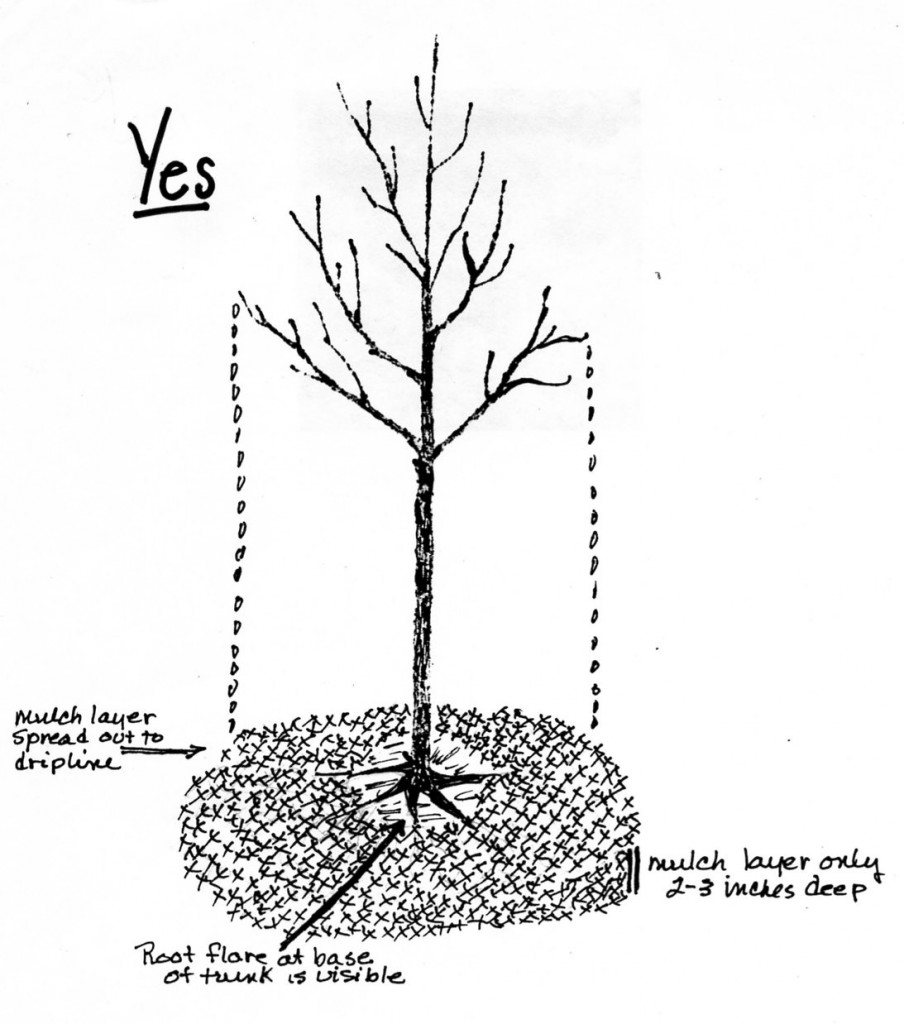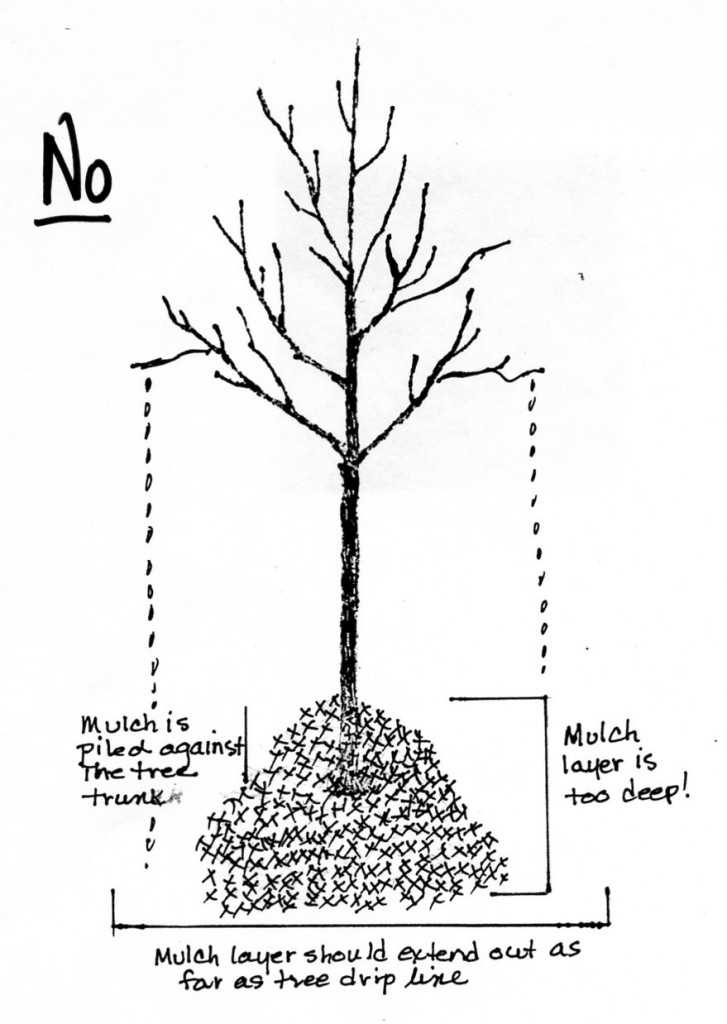preading a protective layer of some sort of organic mulch over the bare soil in planting beds and under trees in residential yards is very important. Unfortunately, mulching trees often becomes too much of a good thing, as uninformed homeowners and landscape crews pile wood chips or shredded bark too thickly over the soil and too high up against tree trunks. Rather than protect the tree, this “volcano” mulching can kill it. Because many landscaping companies fail to train their workers on how to properly spread mulch under trees, it is important for homeowners who hire them, (as well as those who do their own mulching in their yards), to be aware of the correct way to mulch trees and shrubs.
Mulch benefits
The bottom line is that trees need to be able to access oxygen in the soil through their roots. That is why roots of most kinds of trees grow and spread relatively shallowly–between 12 and 18 inches below the soil surface–where air is available in the soil. If the air has been pressed out of the soil due to compaction, tree roots will gravitate to the surface in search of air.
A primary role of a mulch of some organic material such as wood chips, shredded bark, chopped leaves or pine needles is to nurture and protect the soil under the tree. Trees in the forest provide their own mulch in the form of their fallen leaves. They lie where they fall beneath the tree to absorb moisture and provide soil nutrients and oxygen as they decompose. However, we usually rake up the fallen leaves of trees in home landscapes, so it is important to provide some sort of replacement that imitates the rich forest floor. A thin layer of mulch over the roots under the tree also discourages competition from turfgrass for soil nutrients, and soil compaction from riding mowers and other yard equipment.
Overmulching wastes mulch (and money) and actually damages trees, reducing their life expectancy. Thick mulch smoothers tree roots by cutting off their oxygen supply. Spread up against the tree’s trunk, organic material generates heat as it decomposes which kills bark tissue. The moist conditions it fosters causes the bark on the trunk to rot. Further, piled on year after year, mulch creates potential habitat for rodents that feed on bark and roots.
Proper tree mulching
- Never let mulch touch the trunk of the tree. Start the mulch layer on the ground about 4 to 6 inches out from the bottom of the trunk. The root flare, where the roots begin to enter the ground at the base of the trunk, should be visible after the mulch is spread.
- Never let the layer of mulch under a tree become deeper than 3 or 4 inches. If last year’s mulch has not decomposed, do not add more this year. Rake and redistribute last year’s so that it can get air and moisture and begin to decompose. Then after a few weeks of hot weather, add a thin new mulch layer if you feel it is necessary.
- Spread a wide layer of mulch to cover the spreading root system. Remember that tree roots typically spread well beyond the reach of a tree’s branch canopy. So, extend the mulch layer as least as far as that. For larger trees this may not be practical, but the idea is to cover the root area as much as possible. This will also eliminate the risk of bark damage from mowing or weed trimming too close to the trunk. Most importantly, while the decomposing mulch enriches and lightens the soil over the roots, it also fosters microbial activity which generates nutrients to fertilize the tree for you.
- Mulch newly planted trees. While a layer of organic mulch is good for them and looks good, older, long-established trees do not need it. However, newly planted young trees or transplanted older ones really benefit from mulch. It gets them off to a safe, good start by eliminating competition for soil nutrients from grass that would otherwise grow over their roots. It also helps retain soil moisture. Spread the mulch out beyond the planting hole and any stakes that you use the first year to support the newly planted tree.
- Use only organic mulch, and use it by itself. Stone or gravel mulches do not benefit trees or soil. They store heat, are difficult to weed and become a nuisance when stones migrate into the lawn. Plastic does not help trees either. Placed between the ground and the layer of organic mulch to prevent weeds, it blocks moisture and the critical exchange of oxygen and nutrients from the decomposing mulch to the soil. Avoid landscape fabric too. It does allow air and moisture exchange, but the valuable organic matter from decomposed mulch is not able to infiltrate the barrier and incorporate into the soil over the tree’s roots. Organic mulches do not prevent weeds, but those weeds that develop are easy to pull from the mulch layer.
- Choose an organic mulch which looks natural. Mulch is intended to be an inconspicuous landscape element, a protective cover. Properly selected and spread, it shows plants to their best advantage and does not compete with them for attention.
By Liz Ball, Marple Tree Commission



